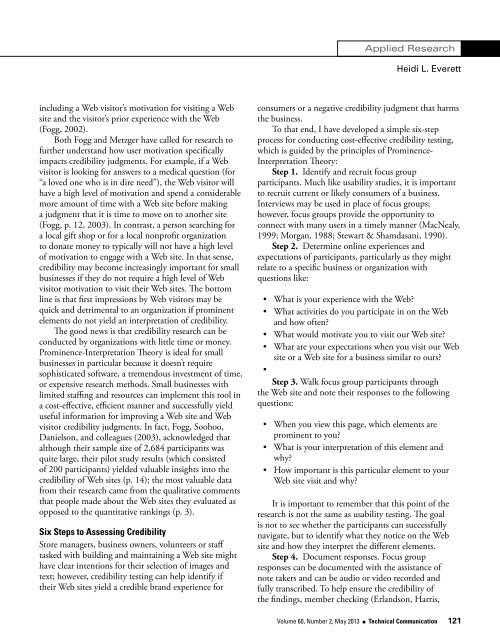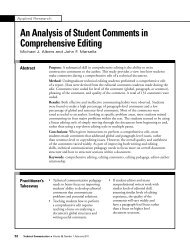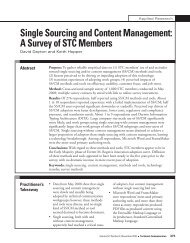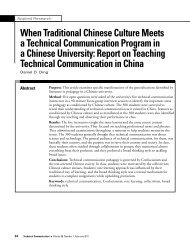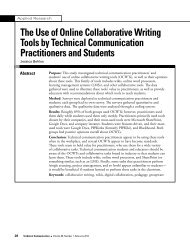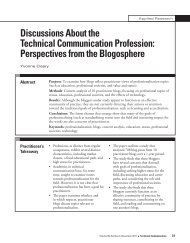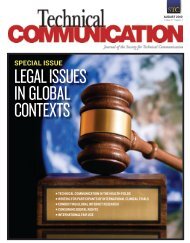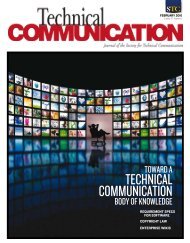Amateur Hour Credibility Testing for Small Business Web Sites
Credibility Testing for Small Business Web Sites - Technical ...
Credibility Testing for Small Business Web Sites - Technical ...
- No tags were found...
You also want an ePaper? Increase the reach of your titles
YUMPU automatically turns print PDFs into web optimized ePapers that Google loves.
Applied ResearchHeidi L. Everettincluding a <strong>Web</strong> visitor’s motivation <strong>for</strong> visiting a <strong>Web</strong>site and the visitor’s prior experience with the <strong>Web</strong>(Fogg, 2002).Both Fogg and Metzger have called <strong>for</strong> research tofurther understand how user motivation specificallyimpacts credibility judgments. For example, if a <strong>Web</strong>visitor is looking <strong>for</strong> answers to a medical question (<strong>for</strong>“a loved one who is in dire need”), the <strong>Web</strong> visitor willhave a high level of motivation and spend a considerablemore amount of time with a <strong>Web</strong> site be<strong>for</strong>e makinga judgment that it is time to move on to another site(Fogg, p. 12, 2003). In contrast, a person searching <strong>for</strong>a local gift shop or <strong>for</strong> a local nonprofit organizationto donate money to typically will not have a high levelof motivation to engage with a <strong>Web</strong> site. In that sense,credibility may become increasingly important <strong>for</strong> smallbusinesses if they do not require a high level of <strong>Web</strong>visitor motivation to visit their <strong>Web</strong> sites. The bottomline is that first impressions by <strong>Web</strong> visitors may bequick and detrimental to an organization if prominentelements do not yield an interpretation of credibility.The good news is that credibility research can beconducted by organizations with little time or money.Prominence-Interpretation Theory is ideal <strong>for</strong> smallbusinesses in particular because it doesn’t requiresophisticated software, a tremendous investment of time,or expensive research methods. <strong>Small</strong> businesses withlimited staffing and resources can implement this tool ina cost-effective, efficient manner and successfully yielduseful in<strong>for</strong>mation <strong>for</strong> improving a <strong>Web</strong> site and <strong>Web</strong>visitor credibility judgments. In fact, Fogg, Soohoo,Danielson, and colleagues (2003), acknowledged thatalthough their sample size of 2,684 participants wasquite large, their pilot study results (which consistedof 200 participants) yielded valuable insights into thecredibility of <strong>Web</strong> sites (p. 14); the most valuable datafrom their research came from the qualitative commentsthat people made about the <strong>Web</strong> sites they evaluated asopposed to the quantitative rankings (p. 3).Six Steps to Assessing <strong>Credibility</strong>Store managers, business owners, volunteers or stafftasked with building and maintaining a <strong>Web</strong> site mighthave clear intentions <strong>for</strong> their selection of images andtext; however, credibility testing can help identify iftheir <strong>Web</strong> sites yield a credible brand experience <strong>for</strong>consumers or a negative credibility judgment that harmsthe business.To that end, I have developed a simple six-stepprocess <strong>for</strong> conducting cost-effective credibility testing,which is guided by the principles of Prominence-Interpretation Theory:Step 1. Identify and recruit focus groupparticipants. Much like usability studies, it is importantto recruit current or likely consumers of a business.Interviews may be used in place of focus groups;however, focus groups provide the opportunity toconnect with many users in a timely manner (MacNealy,1999; Morgan, 1988; Stewart & Shamdasani, 1990).Step 2. Determine online experiences andexpectations of participants, particularly as they mightrelate to a specific business or organization withquestions like:• What is your experience with the <strong>Web</strong>?• What activities do you participate in on the <strong>Web</strong>and how often?• What would motivate you to visit our <strong>Web</strong> site?• What are your expectations when you visit our <strong>Web</strong>site or a <strong>Web</strong> site <strong>for</strong> a business similar to ours?•Step 3. Walk focus group participants throughthe <strong>Web</strong> site and note their responses to the followingquestions:• When you view this page, which elements areprominent to you?• What is your interpretation of this element andwhy?• How important is this particular element to your<strong>Web</strong> site visit and why?It is important to remember that this point of theresearch is not the same as usability testing. The goalis not to see whether the participants can successfullynavigate, but to identify what they notice on the <strong>Web</strong>site and how they interpret the different elements.Step 4. Document responses. Focus groupresponses can be documented with the assistance ofnote takers and can be audio or video recorded andfully transcribed. To help ensure the credibility ofthe findings, member checking (Erlandson, Harris,Volume 60, Number 2, May 2013 l Technical Communication 121


